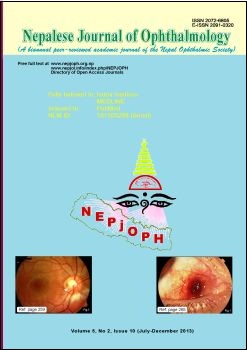Central Retinal Arterial Occlusion (CRAO) after Phacoemulsification-A Rare Complication
DOI:
https://doi.org/10.3126/nepjoph.v5i2.8746Keywords:
Central retinal artery occlusion, peribulbar anesthesia, phacoemulsificationAbstract
Background: While peribulbar anesthesia is generally safe, a remote risk of retinal vascular accident exists and its routine use should be done with caution.
Objective: To report a case of central retinal artery occlusion (CRAO) that occurred within 24 hours of routine uneventful phacoemulsification cataract surgery using peribulbar anesthesia. We share our experience of a 45-year old man who underwent uneventful clear corneal temporal incision phacoemulsification cataract surgery using peribulbar lignocain injection with adrenaline.
Case: A Patient who underwent routine phacoemulsification surgery of left eye for posterior sub-capsular cataract under peribulbar anesthesia developed central retinal artery occlusion in the immediate post-operative period. The surgery was uneventful.
Conclusion: Central retinal artery occlusion is a rare but dreadful complication seen after uneventful phacoemulsification and the cause is mainly due to anesthesia related.
Nepal J Ophthalmol 2013; 5(10): 281-283
Downloads
Downloads
Published
How to Cite
Issue
Section
License
This license enables reusers to copy and distribute the material in any medium or format in unadapted form only, for noncommercial purposes only, and only so long as attribution is given to the creator.




